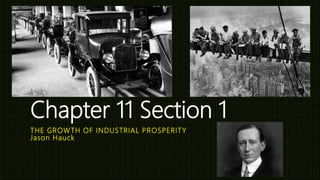
Chapter 11 section 1 power point
- 1. THE GROWTH OF INDUSTRIAL PROSPERITY Jason Hauck Chapter 11 Section 1
- 2. I. The Second Industrial Revolution A. The first Industrial Revolution had given rise to textiles, railroads, iron, and coal. 1. In the Second Industrial Revolution, steel, chemicals, electricity, and petroleum led the way to new industrial frontiers. B. Bessemer process created a new method for making high- quality steel efficiently and cheaply. 1. Steel soon replaced iron and was used in the building of lighter, smaller, and faster machines and engines. 2. In 1860 Great Britain, France, Germany, and Belgium produced 125,000 tons of steel. a. By 1913, the total was 32 million tons.
- 3. C.Electricity was a valuable new form of energy. 1. It was easily converted into other energy forms, such as heat, light, and motion. 2.Hydroelectric power stations and coal-fired steam- generating plants connected homes and factories to a common source of power.
- 5. D.Electricity gave birth to a series of inventions. 1. Thomas Edison in the United States and Joseph Swan in Great Britain created the lightbulb. 2.Alexander Graham Bell invented the telephone in 1876. 3.Guglielmo Marconi sent the first radio waves across the Atlantic Ocean in 1901.
- 7. E. By the 1880s, streetcars and subways powered by electricity had appeared in major European cities. 1. With electric lights, factories could remain open 24 hours a day. F. The development of the internal-combustion engine, provided a new source of power in transportation. 1. This engine gave rise to ocean liners with oil-fired engines, as well as to the airplane and the automobile. a.In 1903 Orville and Wilbur Wright made the first flight in a fixed-wing plane at Kitty Hawk, North Carolina.
- 10. G.Industrial production grew at a rapid pace because of greatly increased sales of manufactured goods. 1. Europeans could afford to buy more consumer products for several reasons. a.Wages for workers increased and prices for manufactured goods were lower because of reduced transportation costs. 2.Henry Ford developed the assembly line in 1913. a.It allowed a much more efficient mass production of goods.
- 11. H. Not everyone benefited from the Second Industrial Revolution. 1. Europe was divided into two economic zones. a. Great Britain, Belgium, France, the Netherlands, Germany, the western part of the Austro-Hungarian Empire, and northern Italy made up an advanced industrialized core. i. These nations had a high standard of living and adequate systems of transportation. 2. Another part of Europe to the south and east was still largely agricultural. a. Southern Italy, most of Austria-Hungary, Spain, Portugal, the Balkan kingdoms, and Russia. i. They provided food and raw materials for the industrial countries and had a much lower standard of living than the rest of Europe.
- 12. II. Organizing the Working Classes A.The transition to an industrialized society was very hard on workers. 1. The desire to improve their working and living conditions led many industrial workers to form socialist political parties and socialist trade unions. a.One form of socialism was eventually called communism. B. In 1848 The Communist Manifesto was published by Karl Marx and Friedrich Engels, who were appalled at the horrible conditions in the industrial factories. 1. They blamed the system of industrial capitalism for these conditions.
- 14. C.Marx believed that all of world history was a "history of class struggles." 1. According to Marx, a.The oppressors—owned the means of production, such as land, raw materials, and money. i. The bourgeoisie. b.The oppressed—owned nothing and depended on the owners of the means of production. i. The Proletariat.
- 15. D.Marx predicted that the struggle between the two groups would lead to a revolution. 1. The proletariat would violently overthrow the bourgeoisie. a.After their victory, the proletariat would form a dictatorship to organize the means of production. b.This would essentially abolish the economic differences that create separate social classes, Marx believed that the revolution would produce a classless society.
- 16. E. In time, working-class leaders formed socialist parties based on Marx's ideas. 1. The German Social Democratic Party (SPD), which emerged in 1875. a.They advocated revolution while organizing itself into a mass political party that competed in elections for the German parliament. b.When in parliament, SPD delegates worked to pass laws that would improve conditions for the working class.
- 17. F. Socialist parties also emerged in other European states. In 1889 leaders of the various socialist parties joined together and formed the Second International. 1. An association of national socialist groups that would fight against capitalism worldwide. G.Marxist parties were divided over their goals. 1. Pure Marxists thought that capitalism could be defeated only by a violent revolution. 2.Other Marxists, called revisionists, rejected the revolutionary approach.
- 18. H.The trade union, or labor union helped with revolutionary change. 1. The right to strike was an important part of the trade union movement. a.In Great Britain, unions won the right to strike in the 1870s. b.By 1914, there were almost 4 million workers in British trade unions.
